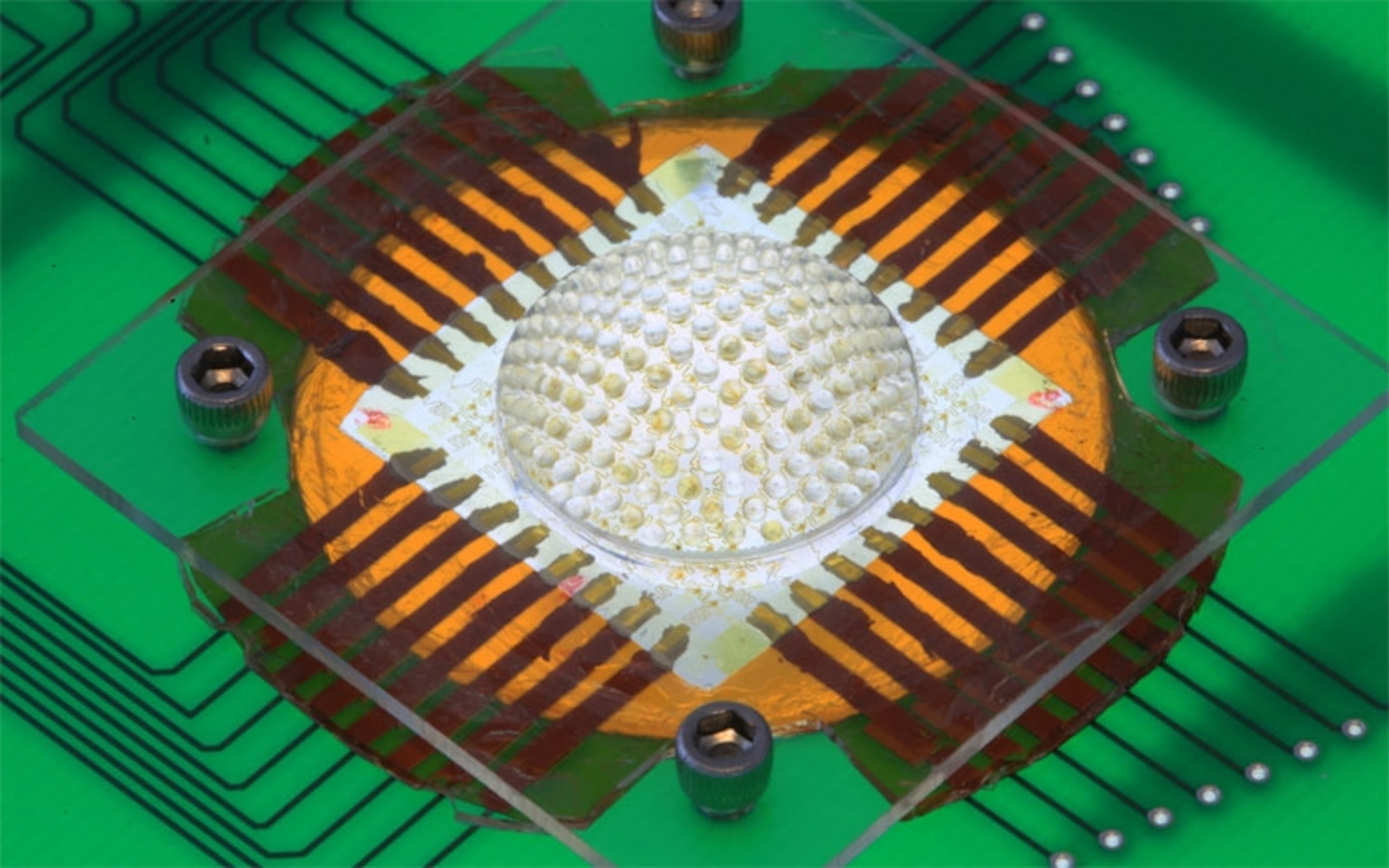
Insect-Eye Digital Camera Sees What You Just Did
Almost all of our cameras form images by using a single lens to focus light onto a light-sensitive sheet. That’s how our own eyes actually work, but there are many other ways of seeing the world. Arthropods—insects, spiders and their kin—have compound eyes, which consist of hundreds or thousands of individual units or ommatidia. Each one has its own lens and light detectors. They form separate images, which are then united in the brain. And since arthropods greatly outnumber all other animals, the vast majority of eyes are compound ones.
Now, John Rogers from the University of Illinois at Urbana-Champaign has developed a camera that mimics compound eyes. It might not have the same resolution as a state-of-the-art digital camera, but it compensates with many advantages that make it ideal for surveillance. Perhaps in the future, we’ll be watched by man-made flies on the walls.
Rogers chose to mimic apposition eyes—a type of compound eye where each ommatidium sees a narrow part of the insect’s visual field, effectively capturing just one pixel of a full image.
First, his team makes a grid of tiny light-sensitive diodes out of silicon. They’re connected by flexible S-shaped wires that allow the grid to flex without breaking. On top of that, they lay a sheet of silicone (PDMS) that’s moulded into small bubble-shaped lenses, one sitting over each diode. The two layers are fused together and deformed into a dome. Each diode-and-lens combo acts as an ommatidium and the full camera has 180 of them, each pointing in a slightly different direction.

The camera builds on decades of Rogers’ work on flexible electronics—devices that are largely made of brittle, rigid materials like silicon, but can flex and curve like living tissues. He has created “electronic-skin” that can be applied like tattoos and used to measure muscle and nerve activity, sensors that can mould to the shape of the brain or heart, and even electronics that dissolve over time.
Rogers’ inventions include a flexible camera that’s based on our own eyes. Like other cameras, this one has a lens and a sheet of light detectors that acts as a retina. But while modern cameras have flat ‘retinas’, Rogers’ machine has a curved one, just like our actual eyes. This makes it more compact. Much of the weight of modern cameras comes from bulky secondary lenses that correct the incoming light so it can project onto a flat surface without distortions. With a curved retina, you don’t need these lenses, and the camera can shrink.
With one eyeball camera in the works, it might seem strange that the team decided to build a compound one too. After all, compound eyes—especially apposition ones—aren’t that sensitive to light and have fairly low resolution. Dan-E. Nilsson, who studies insect vision at Lund University, says, “The type of compound eye they have mimicked has long been known to be a poor solution to vision. And to have one private lens for every pixel in the image is the most inefficient use possible of the space available for an eye.”
But, wait! Compound eyes have some advantages. Since their ommatidia point in all directions, they give their owners a panoramic 180-degree view of the world that’s clear over the entire field of view. By contrast, our eyes can only see a narrow angle ahead of us, and the images they form are only sharp at the very centre of our visual field.
Compound eyes also have an almost infinite depth of field—that is, objects stay in focus regardless of how far they are from the eye. So, flies can clearly see something far and near objects at the same time, without having to adjust any lenses. And compound eyes are also exquisitely sensitive to movement, since their owners can compare the passage of shapes across different ommatidia.
Wide angles. Sharp focus at all distances. Sensitivity to movement. If you were building a surveillance camera, these are exactly the properties you’d want. Indeed, Rogers thinks that surveillance is an obvious application for his fly-eye design.
In a related editorial, Alexander Borst and Johannes Plett from the Max-Planck-Institute of Neurobiology suggest that the cameras might be useful for controlling tiny drones. At the moment, these use normal cameras with fish-eye lenses to give them a wide field of view. An insect-eye camera could do the same, while possibly making the robot more sensitive to movements.
“It’s great work, and a nice example of biomimetics,” says Nicholas Roberts from the University of Bristol, who studies animal eyes. Although it doesn’t tell us anything that “crosses back to biology”, the camera’s huge depth of field is a “nice benefit over single lens designs”.
And though Rogers admits that while the fly-eye camera will never match the resolution of a normal one, he thinks that’s not a deal-breaker. “If you can combine multiple images over time, you can effectively get a high resolution,” he says. “Surveillance cameras use this trick to spot speeding cars – the resolution from a single frame can’t identify the letters on a licence plate.”
There’s obviously room for improvement but with 180 ommatidia, the digital camera is already more sophisticated than the eyes of some insects—some worker ants, for example, only have 100 in each eye. But it’s a long way off from the best insect eyes, like those of the green darner dragonfly (28,000 ommatidia) or the praying mantis (15,000). For the moment, nature still wins.
Reference: Song, Xie, Malyarchuk, Xiao, Jung, Choi, Liu, Park, Lu, Kim, Crozier, Huang & Rogers. 2013. Digital cameras with designs inspired by the arthropod eye. Nature http://dx.doi.org/10.1038/nature12083
